New Materials Based on Ethylene Propylene Diene Terpolymer and Hemp Fibers Obtained by Green Reactive Processing
Abstract
:1. Introduction
2. Materials and Methods
2.1. Materials
2.2. Sample Preparation
2.3. Experimental Installations and Sample Irradiation
2.4. Laboratory Tests
2.4.1. Mechanical Characteristics
2.4.2. Sol–Gel Analysis
2.4.3. The Crosslinking Density ()
2.4.4. Rubber–Fiber Interactions
2.4.5. Water Uptake Test
2.4.6. Fourier Transform Infrared Spectroscopy (FTIR)Analysis
3. Results and Discussion
3.1. Mechanical Properties
3.2. Gel Fraction
3.3. Crosslink Density
3.4. Rubber–Fiber Interactions
3.5. Water Uptake
3.6. Fourier Transform Infrared Spectroscopy (FTIR) Analysis
4. Conclusions
Author Contributions
Funding
Conflicts of Interest
References
- Thakur, V.; Han, T.; Wu, S.R.; Shan, C.L.P. Development of High Temperature Resistant Coolant Hose Compounds with EPDM. KGK KautGummiKunst. 2019, 72, 46–51. [Google Scholar]
- Thakur, V.; Shan, C.L.P.; Li, G.; Han, T.; Doelder, J.D. Sponge EPDM by design. Plast. Rubber Compos. 2019, 48, 32–41. [Google Scholar] [CrossRef]
- Van Duin, M.; Hough, P. Green EPDM Compounds. KGK KautGummiKunst. 2018, 71, 26–37. [Google Scholar]
- Dhakal, H.N.; Zhang, Z. Series: Woodhead Publishing Series in Composites Science and Engineering. In Biofiber Reinforcements in Composite Materials; Faruk, O., Sain, M., Eds.; Elsevier: Amsterdam, The Netherlands, 2015; Chapter 3; pp. 86–103. [Google Scholar] [CrossRef]
- Mazian, B.; Bergeret, A.; Benezet, J.C.; Malhautier, L. Impact of field retting and accelerated retting performed in a lab-scale pilot unit on the properties of hemp fibres/polypropylene biocomposites. Ind. Crops Prod. 2020, 143. [Google Scholar] [CrossRef]
- Bourmaud, A.; Beaugrand, J.; Shah, D.U.; Baley, V.P.C. Towards the design of high-performance plant fibrecomposites: How can we best define the diversity and specificities of plant cell walls? Prog. Mater. Sci. 2018, 97, 347–408. [Google Scholar] [CrossRef]
- Pickering, K.L.; Efendy, M.G.A.; Le, T.M. A review of recent developments in natural fibre composites and their mechanical performance. Compos. Part A Appl. Sci. Manuf. 2016, 83, 98–112. [Google Scholar] [CrossRef] [Green Version]
- Cao, Y.; Wu, Y. Evaluation of statistical strength of bamboo fiber and mechanical properties of fiber reinforced green composites. J. Cent. South Univ. Technol. 2008, 15, 564–567. [Google Scholar] [CrossRef]
- Lee, B.H.; Kim, H.J.; Yu, W.R. Fabrication of long and discontinuous natural fiber reinforced polypropylene biocomposites and their mechanical properties. Fibers Polym. 2009, 10, 83–90. [Google Scholar] [CrossRef]
- Manaia, J.P.; Manaia, A.T.; Rodriges, L. Industrial Hemp Fibers: An Overview. Fibers 2019, 7, 106. [Google Scholar] [CrossRef] [Green Version]
- Mwaikambo, L.Y. Review of history, properties, and application of plant fibres. Afr. J. Sci. Technol. 2006, 7, 120–133. [Google Scholar]
- Faruk, O.; Bledzki, A.K.; Fink, H.P.; Sain, M. Biocomposites reinforced with natural fibers: 2000–2010. Prog. Polym. Sci. 2012, 37, 1552–1596. [Google Scholar] [CrossRef]
- Sanjay, M.R.; Madhu, P.; Jawaid, M.; Senthamaraikannan, P.; Senthil, S.; Pradeep, S. Characterization and properties of natural fiber polymer composites: A comprehensive review. J. Clean. Prod. 2018, 172, 566–581. [Google Scholar] [CrossRef]
- Wu, Y.; Xia, C.; Cai, L.; Garcia, C.A.; Shi, Q.S. Development of natural fiber-reinforced composite with comparable mechanical properties and reduced energy consumption and environmental impacts for replacing automotive glass-fiber sheet molding compound. J. Clean Prod. 2018, 184, 92–100. [Google Scholar] [CrossRef]
- Kumarjyoti, R.; Subhas, C.D.; Lazaros, T.; Aphiwat, P.; Pranut, P. Efect of Various Surface Treatments on the Performance of Jute Fibers Filled Natural Rubber (NR) Composites. Polymers 2020, 12, 369. [Google Scholar] [CrossRef] [Green Version]
- Güven, O.; Monteiro, S.N.; Moura, E.A.B.; Drelich, J.W. Re-emergingfield of lignocellulosic fiber-polymer composites and ionizing radiations technology in their formulation. Polym. Rev. 2016, 56, 702–736. [Google Scholar] [CrossRef]
- Stelescu, M.D.; Manaila, E.; Craciun, G.; Zuga, N. Crosslinking and Grafting Ethylene-Propylene—Terpolymer Rubber with Accelerated Electrons in the Presence of Polyfunctional Monomers. In Proceedings of the 4th International Conference on Advanced Materials and Systems, Bucharest, Romania, 27–29 September 2012; Albu, L., Deselnicu, V., Eds.; EdituraCertex: Bucharest, Romania, 2012; pp. 383–388. [Google Scholar]
- Eyssa, H.M.; Abulyazied, D.E.; Abdulrahman, M.; Youssef, H.A. Mechanical and physical properties of nanosilica/nitrile butadiene rubber composites cured by gamma irradiation. Egypt. J. Pet. 2018, 27, 383–392. [Google Scholar] [CrossRef]
- Stelescu, M.D.; Airinei, A.; Manaila, E.; Craciun, G.; Fifere, N.; Varganici, C.; Pamfil, D.; Doroftei, F. Effects of Electron Beam Irradiation on the Mechanical, Thermal, and Surface Properties of Some EPDM/Butyl Rubber Composites. Polymers 2018, 10, 1206. [Google Scholar] [CrossRef] [Green Version]
- Moustafa, A.B.; Mounir, R.; el Miligy, A.A.; Mohamed, M.A. Effect of gamma irradiation on the properties of natural rubber/styrene butadiene rubber blends. Arab. J. Chem. 2016, 9, S124–S129. [Google Scholar] [CrossRef] [Green Version]
- Zaharescu, T.; Jipa, S.; Gigante, B. Stabilized polyethylene on the sterilization dose range. Polym. Bull. 2006, 57, 729–735. [Google Scholar] [CrossRef]
- Navarro, R.; Burillo, G.; Adem, E.; Marcos-Fernández, A. Effect of Ionizing Radiation on the Chemical Structure and the Physical Properties of Polycaprolactones of Different Molecular Weight. Polymers 2018, 10, 397. [Google Scholar] [CrossRef] [Green Version]
- Stelescu, M.D.; Airinei, A.; Manaila, E.; Fifere, N.; Craciun, G.; Varganici, C.; Doroftei, F. Exploring the effect of electron beam irradiation on the properties of some EPDM-flax fiber composites. Polym. Compos. 2019, 40, 315–327. [Google Scholar] [CrossRef] [Green Version]
- Manaila, E.; Stelescu, M.D.; Cracium, G.; Surdu, L. Effect of benzoyl peroxide on some properties of composites based on hemp and natural rubber. Polym. Bull. 2014, 71, 2001–2022. [Google Scholar] [CrossRef]
- Shahzad, A. Hemp fiber and its composites—A review. J. Compos. Mater. 2012, 46, 973–986. [Google Scholar] [CrossRef]
- Lopez-Manchado, M.A.; Herrero, B.; Arroyo, M. Preparation and characterization of organoclaynanocomposites based on natural rubber. Polym. Int. 2003, 52, 1070–1077. [Google Scholar] [CrossRef]
- Boye, W.M. Utilizing Coagents in the Electron Beam Cure of Elastomers. In Proceedings of the 57th IWCSInternational Wire & Cable Symposium, Providence, RI, USA, 9–12 November 2008; pp. 335–341. [Google Scholar]
- Kraus, G. Swelling of filler-reinforced vulcanizates. J. Appl. Polym. Sci. 1963, 7, 861–871. [Google Scholar] [CrossRef]
- Zhou, Y.; Wang, S.; Zhang, Y.; Zhang, Y. Reinforcement Effect of MAA on Nano-CaCO3-Filled EPDM Vulcanizates and Possible Mechanism. J. Polym. Sci. B Polym. Phys. 2006, 44, 1226–1236. [Google Scholar] [CrossRef]
- Dhakal, H.N.; Zhang, Z.Y.; Richardson, M.O.W. Effect of water absorption on the mechanical properties of hemp fibre reinforced unsaturated polyester composites. Compos. Sci. Technol. 2007, 67, 1674–1683. [Google Scholar] [CrossRef]
- Volintiru, T.; Ivan, G. Technological Bases for Processing Elastomers; Tehnical Publishing House: Bucharest, Romania, 1974. [Google Scholar]
- Nituica, M.; Stelescu, M.D.; Manaila, E.; Zuga, N.; Meghea, A. The Effect of Filler on Characteristics of some Ethylene Vinyl Acetate Copolymer Composites. In Proceedings of the 5th International Conference on Advanced Materials and Systems, Bucharest, Romania, 23–25 October 2014; Albu, L., Deselnicu, V., Eds.; EdituraCertex: Bucharest, Romania, 2014; pp. 109–114. [Google Scholar]
- Nor, N.A.M.; Othman, N. Effect of Filler Loading on Curing Characteristic and Tensile Properties of Palygorskite Natural Rubber Nanocomposites. Procedia Chem. 2016, 19, 351–358. [Google Scholar] [CrossRef] [Green Version]
- Ismail, H.; Salleh, S.Z.; Ahmad, Z. Properties of halloysite nanotubes-filled natural rubber prepared using different mixing methods. Mat. Des. 2013, 50, 790–797. [Google Scholar] [CrossRef]
- Ahmed, K.; Nizami, S.S.; Raza, N.Z.; Mahmood, K. Effect of micro-sized marble sludge on physical properties of natural rub-be r composites. Chem. Ind. Chem. Eng. Q. 2013, 19, 281–293. [Google Scholar] [CrossRef]
- Ershov, B.G. Radiation-chemical degradation of cellulose and other polysaccharides. Russ. Chem. Rev. 1998, 67, 314–334. [Google Scholar] [CrossRef]
- Charlesby, A.; Pinner, S.H. Analysis of the solubility behaviour of irradiated polyethylene and other polymers. Proc. R. Soc. Lond. Ser. A 1959, 249, 367–386. [Google Scholar]
- Mondal, M.; Gohs, U.; Wagenknecht, U.; Heinrich, G. Efficiency of high energy electrons to produce polypropylene/natural rubber-based thermoplastic elastomer. Polym. Eng. Sci. 2013, 53, 1696–1705. [Google Scholar] [CrossRef]
- Jacob, M.; Varughese, K.T.; Thomas, S. Water sorption studies of hybrid biofiber-reinforced natural rubber biocomposites. Biomacromolecules 2005, 6, 2969–2979. [Google Scholar] [CrossRef] [PubMed]
- Xuan, V.C.; Hanafi, I.; Azura, A.R.; Tsutomu, T.; Thao, V.H. Mechanical properties and water absorption of kenaf powder filled recycled high density polyethylene/natural rubber biocomposites using MAPE as a compatibilizer. BioResources 2011, 6, 3260–3271. [Google Scholar]
- Dong, X.C.; Zhang, Q.L.; Feng, Y.; Xing, Z.; Zhao, J.R. Preparation and Properties of Isobutylene-isoprene Rubber Containing Multifunctional Groups. Iran Polym. J. 2010, 19, 771–779. [Google Scholar]
- Gunasekaran, S.; Natarajan, R.K.; Kala, A. FTIR spectra and mechanical strength analysis of some selected rubber derivatives. Spectrochim. Acta Part A Mol. Biomol. Spectrosc. 2006. [Google Scholar] [CrossRef] [PubMed]
- Fan, M.; Dai, D.; Huang, B. Fourier Transform Infrared Spectroscopy for Natural Fibres. In Fourier Transform—Materials Analysis; Salih, S., Ed.; InTech Europe: Rijeka, Croatia, 2012; pp. 45–68. ISBN 978-953-51-0594-7. [Google Scholar]
- Neves, A.C.; Rohen, L.; Mantovani, D.; Carvalho, J.; Vieira, C.M.; Lopes, F.; Simonassi, N.T.; da Luz, F.; Monteiro, S. Comparative mechanical properties between biocomposites of Epoxy and polyester matrices reinforced by hemp fiber. J. Mater. Res. Technol. 2020, 9, 1296–1304. [Google Scholar] [CrossRef]
- Hospodarova, V.; Singovszka, E.; Stevulova, N. Characterization of Cellulosic Fibers by FTIR Spectroscopy for Their Further Implementation to Building Materials. Am. J. Anal. Chem. 2018, 9, 303–310. [Google Scholar] [CrossRef] [Green Version]
- Deepalaxmi, R.; Rajini, V. Gamma and electron beam irradiation effects on SiR-EPDM blends. J. Radiat. Res. Appl. Sci. 2014, 7, 363–370. [Google Scholar] [CrossRef] [Green Version]
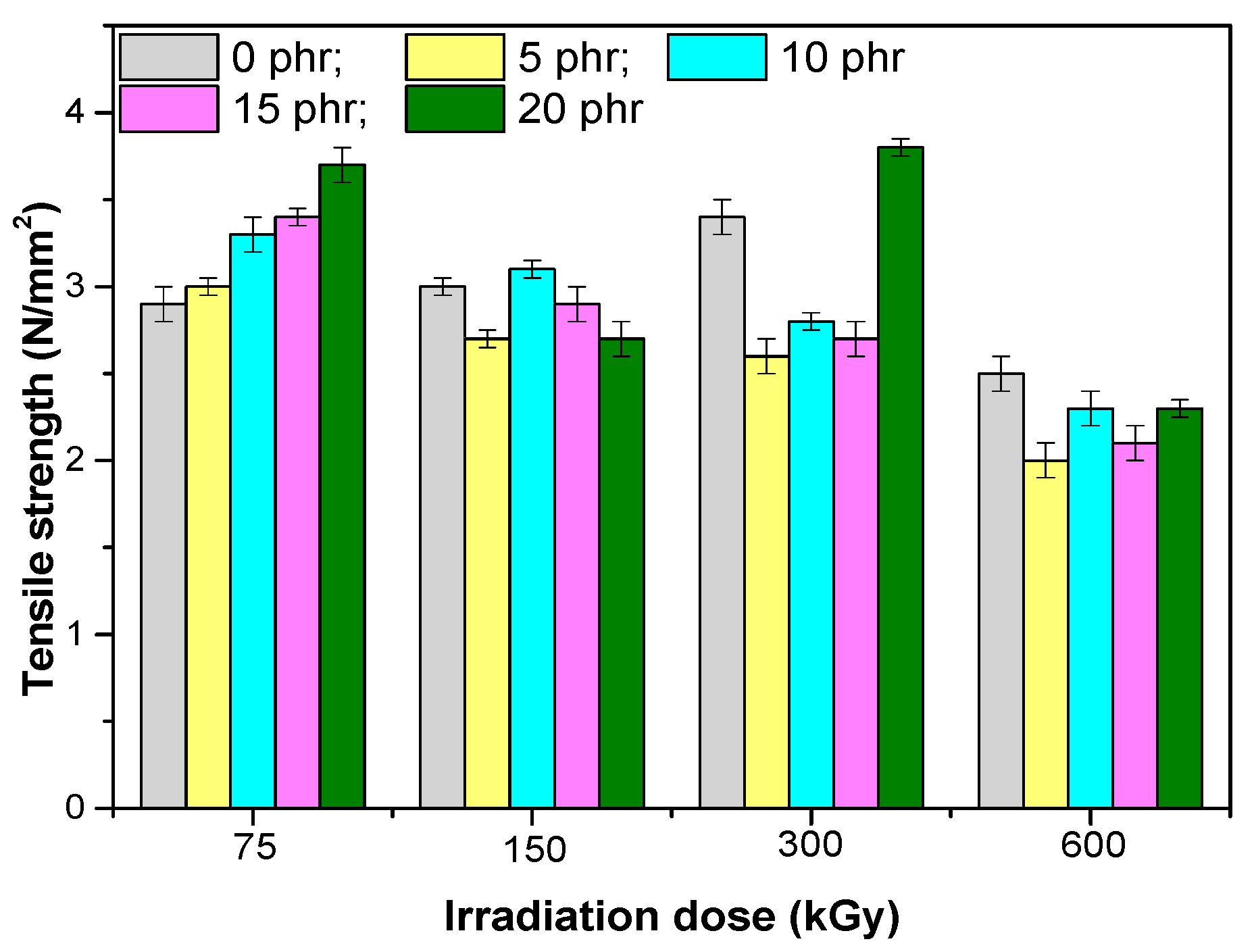

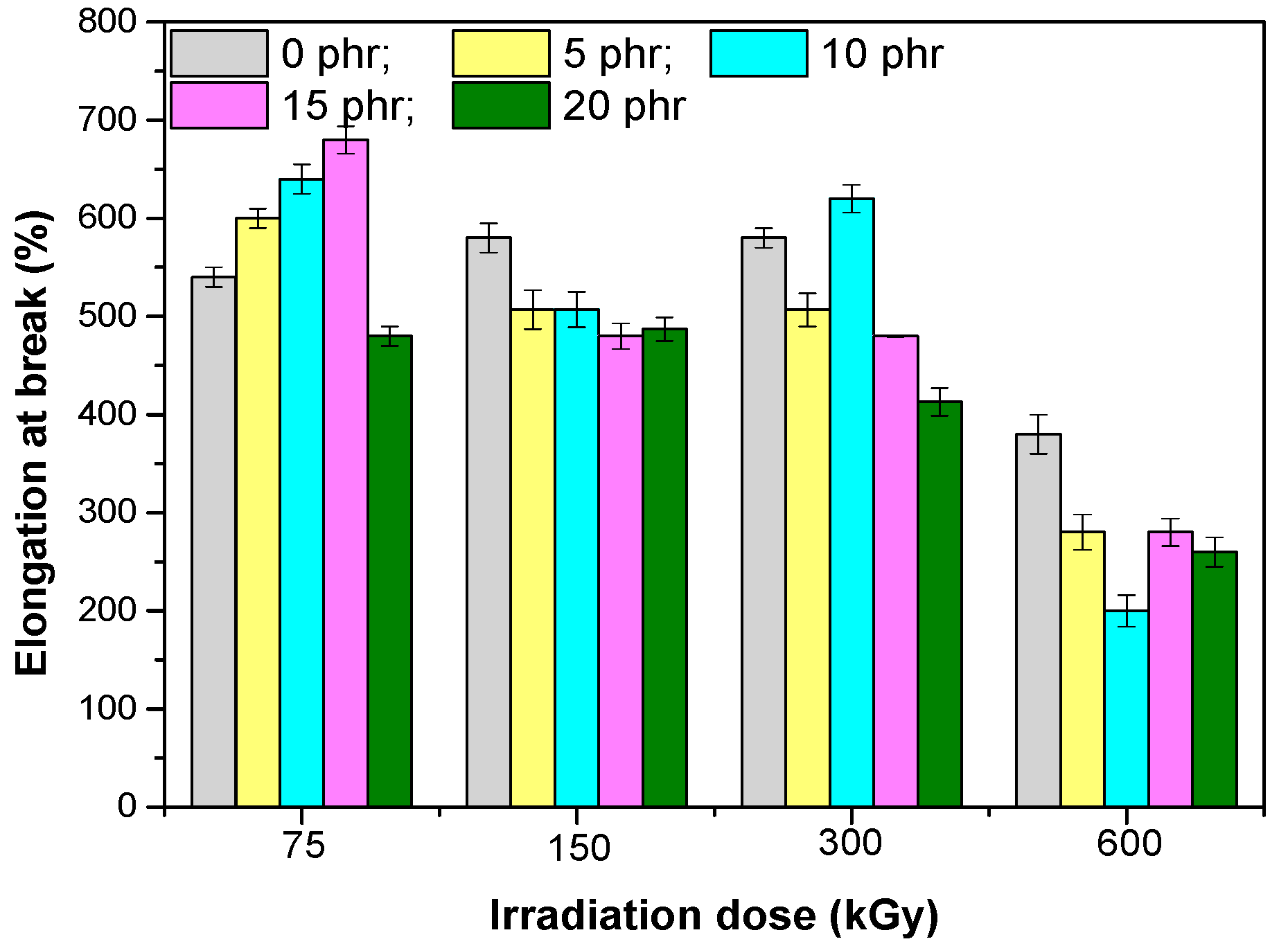
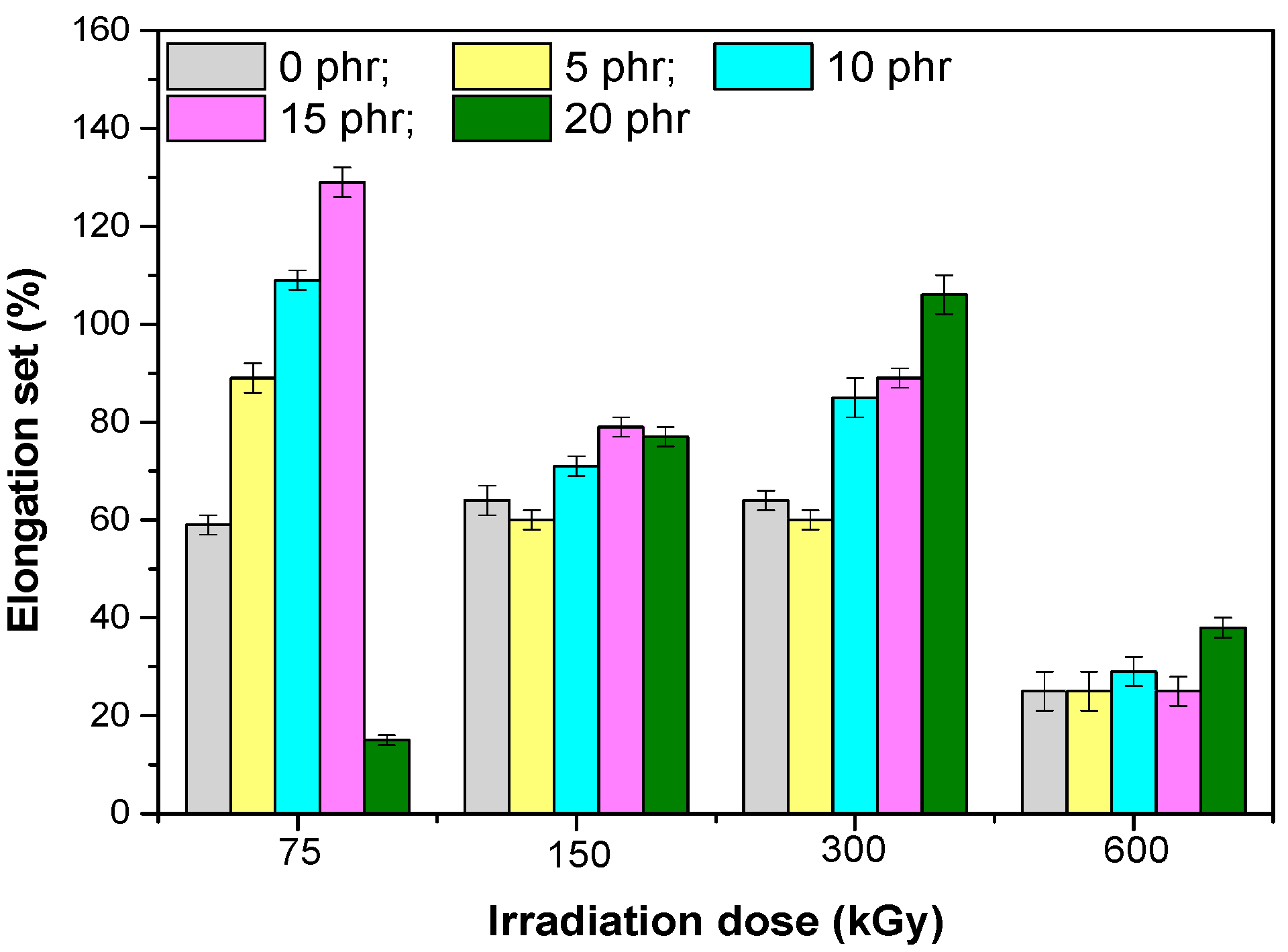

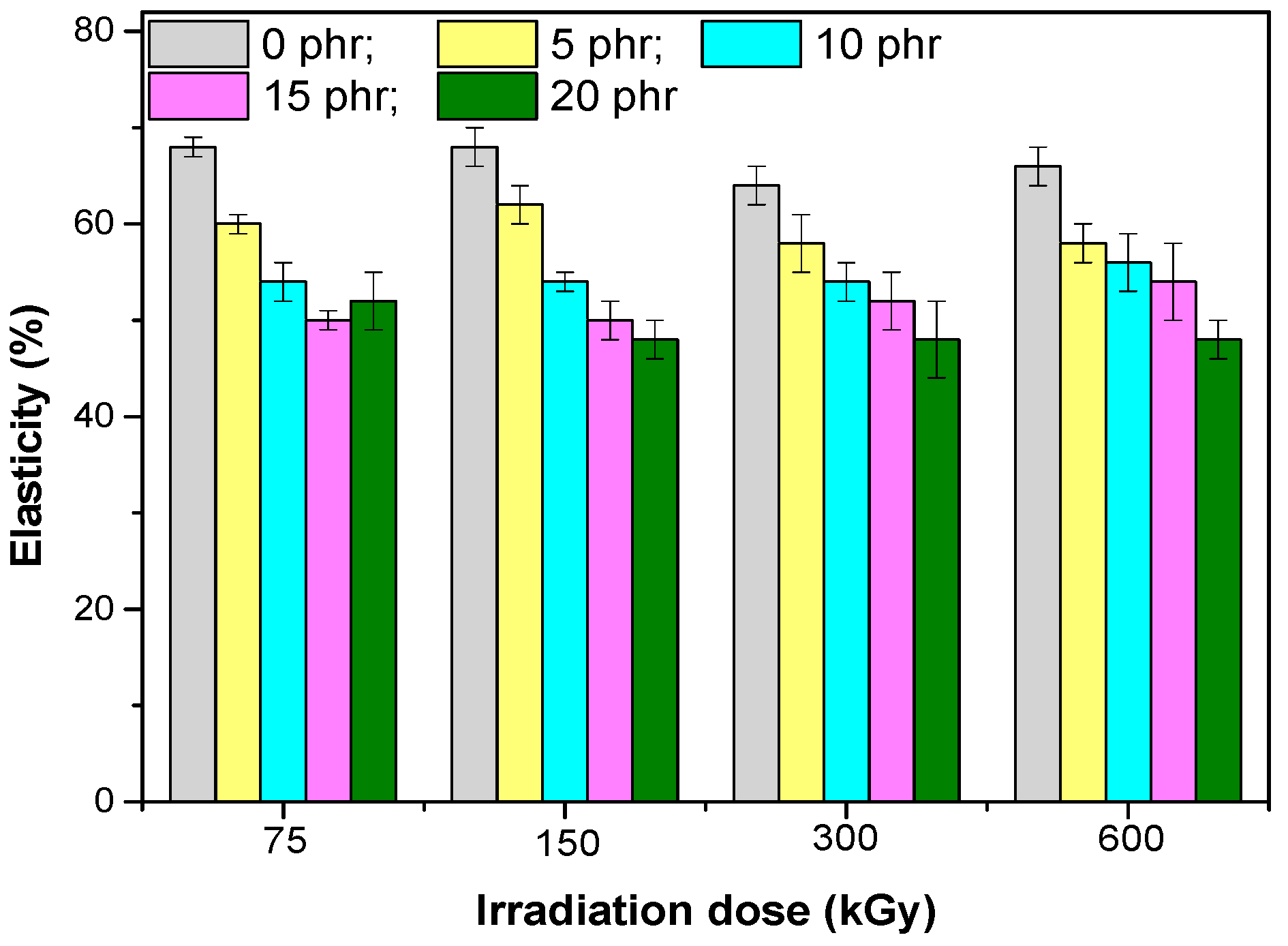
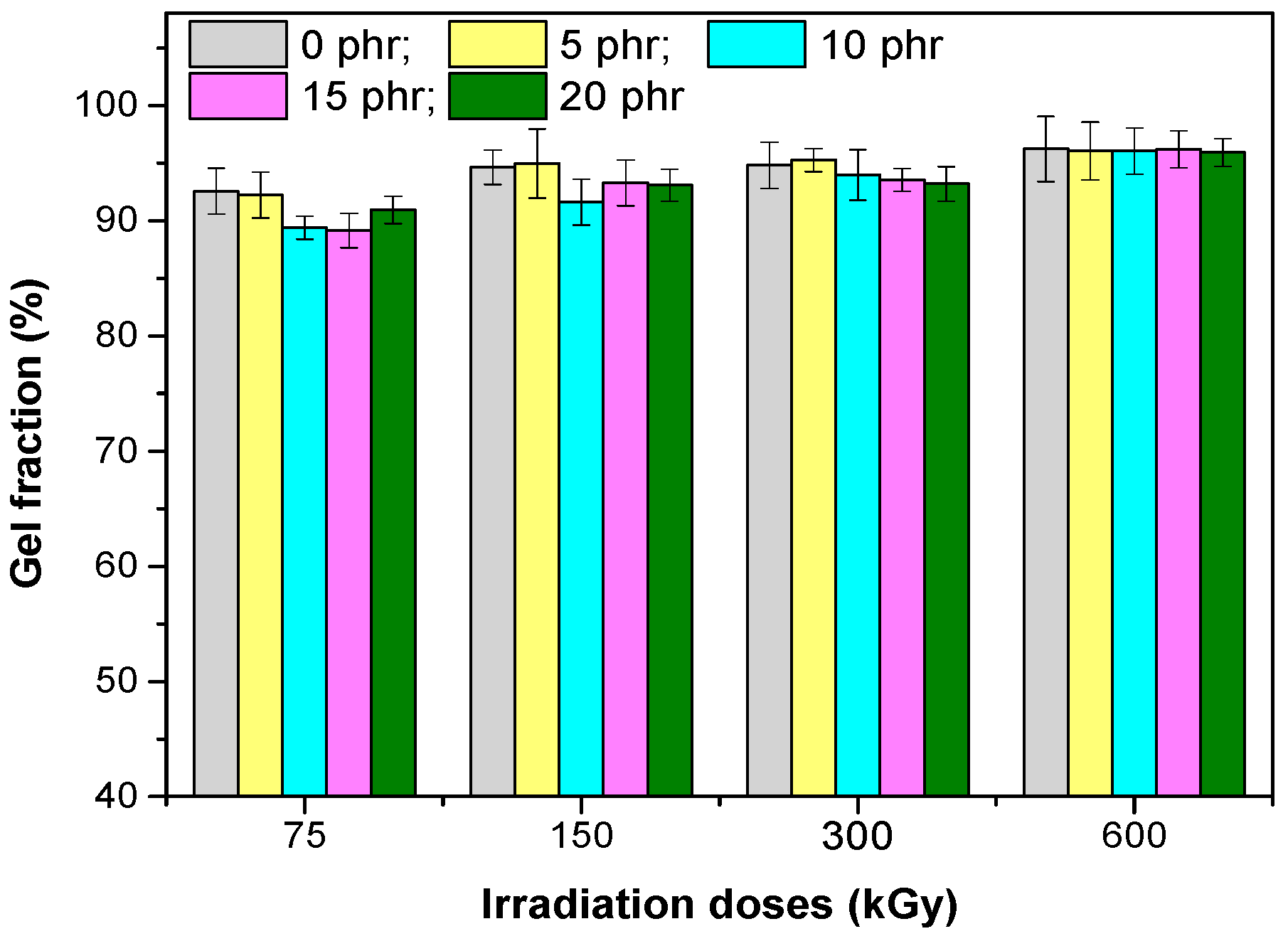

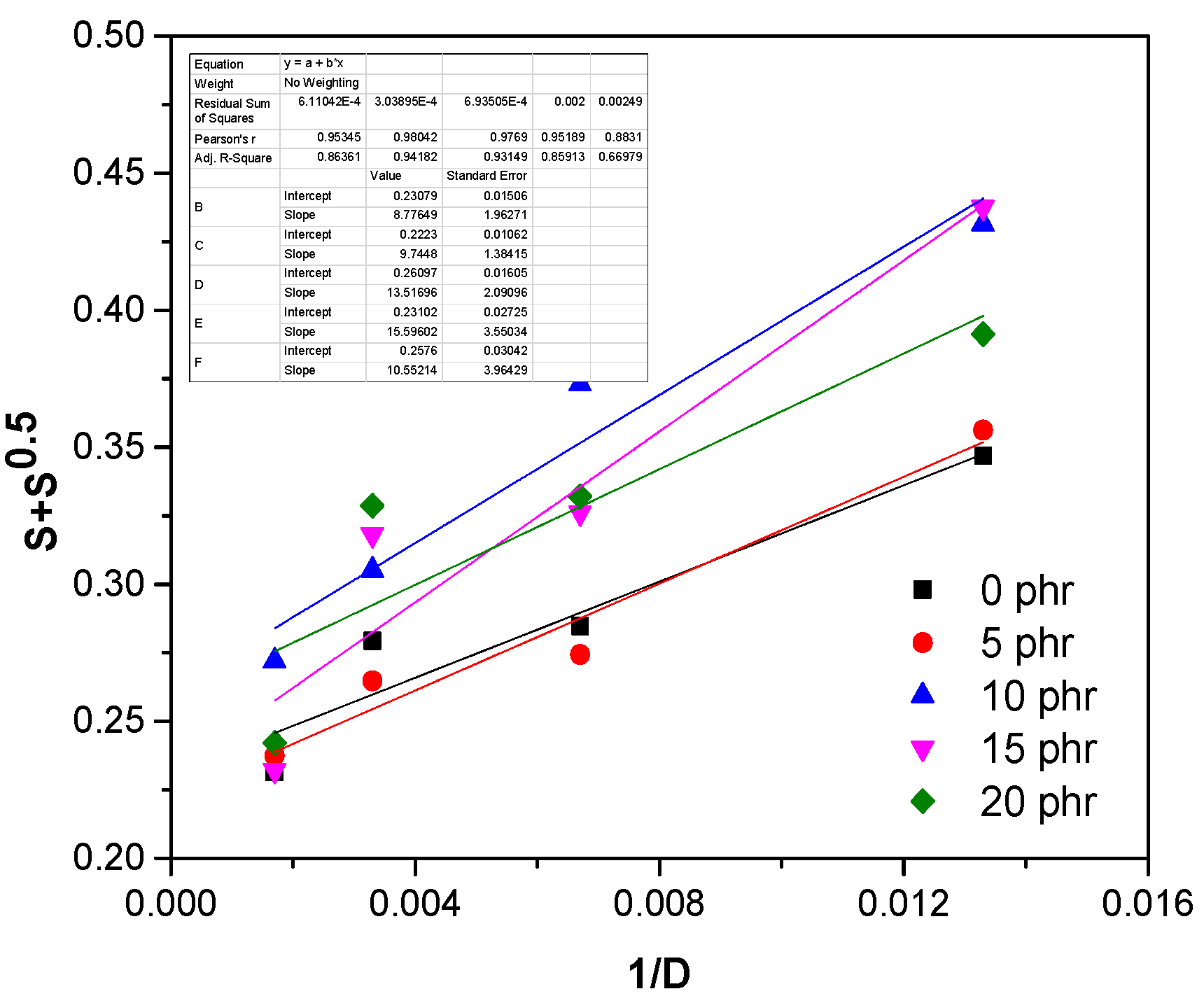



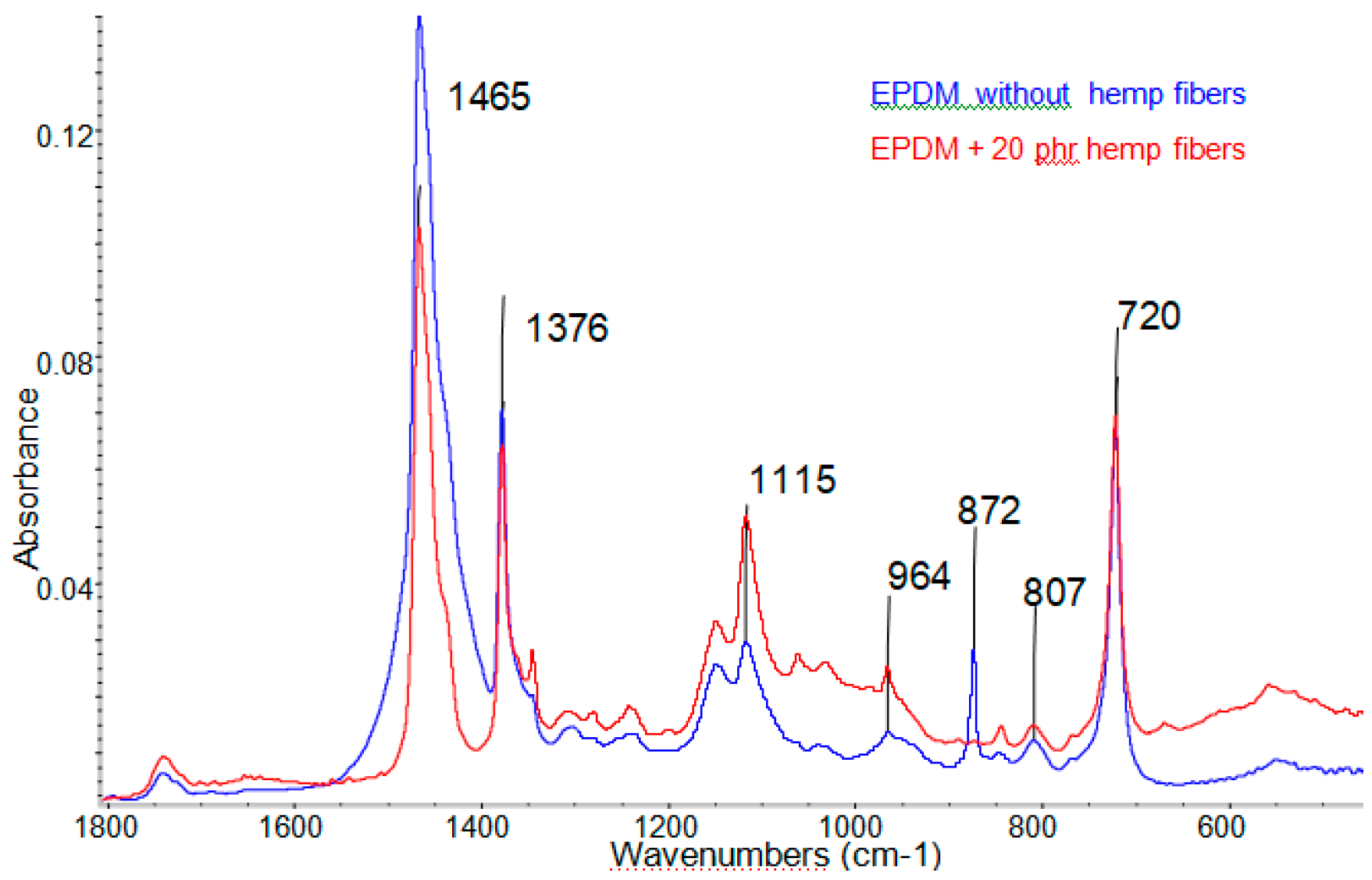
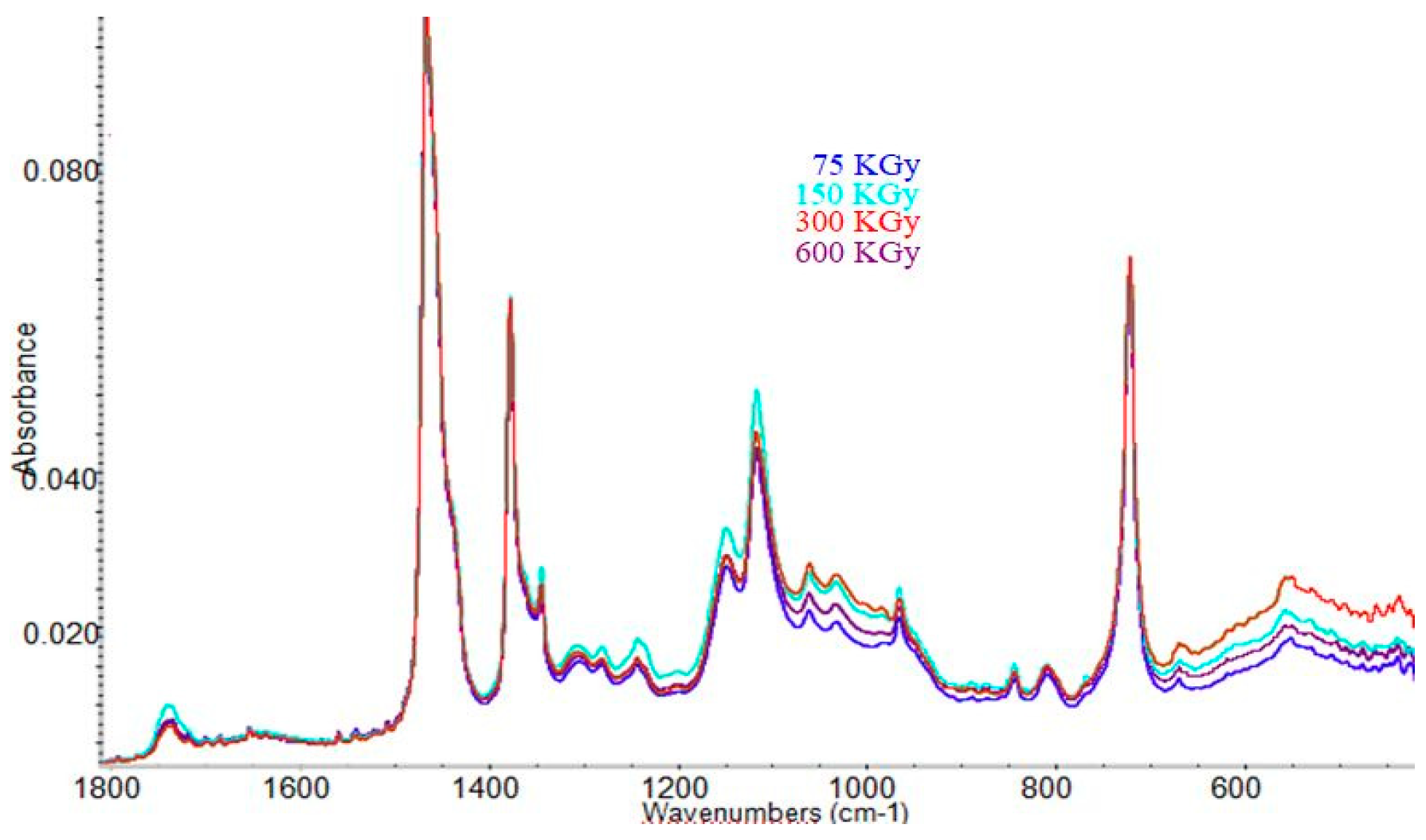
| The Materials | Functions | Properties |
|---|---|---|
| Ethylene-propylene-dieneterpolymersNordel 4760 | Acts as a matrix | Mooney viscosity is 70 ML1+4 at 120 °C, 70% ethylene content, 5-ethylidenenorbornene (ENB) 4.9 wt %, density 0.88 g/cm3, 10% crystalline degree |
| The hemp fiber | Acts as a filler | Thread length of max 2 mmComposition: 68–92 wt % cellulose, 15–22 wt % hemicellulose, 3–10% lignin, 0.8 wt % wax, the rest are fat, pectin [10,11,12,25]. |
| Polyethylene glycolPEG 4000 | Acts as a lubricant and a plasticizer | 1.128 g/cm3 density, 4–8 °C melting point range |
| Irganox 1010 | Acts as an antioxidant | Melting point of 40 °C, 98% active ingredient |
| Ingredients | Loading in phr * |
|---|---|
| EPDM rubber | 100 |
| Hemp fibers | 0–20 |
| PEG 4000 | 3 |
| Antioxidant | 1 |
| Samples | p0/q0 |
| EPDM | 0.2308 |
| EPDM+5 phr hemp | 0.2223 |
| EPDM+10 phr hemp | 0.2610 |
| EPDM+15 phr hemp | 0.2310 |
| EPDM+20 phr hemp | 0.2576 |
| Irradiation Doses (kGy) | The Amount of Hemp Fibers | |||||||
|---|---|---|---|---|---|---|---|---|
| 5 phr | 10 phr | 15 phr | 20 phr | |||||
| Vrf | Vro/Vrf | Vrf | Vro/Vrf | Vrf | Vro/Vrf | Vrf | Vro/Vrf | |
| 75 kGy | 0.229 | 1.209 | 0.254 | 1.089 | 0.257 | 1.077 | 0.248 | 1.113 |
| 150 kGy | 0.305 | 1.139 | 0.314 | 1.106 | 0.316 | 1.098 | 0.301 | 1.152 |
| 300 kGy | 0.309 | 1.260 | 0.330 | 1.180 | 0.332 | 1.174 | 0.302 | 1.243 |
| 600 kGy | 0.362 | 1.222 | 0.381 | 1.161 | 0.359 | 1.233 | 0.356 | 1.288 |
| Band Position in the EPDM-Hemp Composites (cm−1) | Functional Group |
|---|---|
| 1740–1760 | C=O stretch in non-conjugated ketones, carbonyls and in ester groups |
| 1465 | CH2 bending and rocking vibrations from EPDM |
| 1376 | CH3 bending vibration from EPDM |
| 1330–1340 | S ring stretching from cellulose |
| 1115–1330 | C-O-C symmetrical and asymmetrical stretching, OH plane deformation, C-OH bending at C6 |
| 1000–1100 | bond stretching C-O, skeletal vibration C-O, non-symmetric in-phase ring, respectively |
| 730–900 | mono-, di- and tri-substituted C-H bending |
| 720 | CH2 bending and rocking vibrations from EPDM |
| 650–700 | bond stretching of –OH out of phase bending from cellulose |
© 2020 by the authors. Licensee MDPI, Basel, Switzerland. This article is an open access article distributed under the terms and conditions of the Creative Commons Attribution (CC BY) license (http://creativecommons.org/licenses/by/4.0/).
Share and Cite
Stelescu, M.D.; Manaila, E.; Georgescu, M.; Nituica, M. New Materials Based on Ethylene Propylene Diene Terpolymer and Hemp Fibers Obtained by Green Reactive Processing. Materials 2020, 13, 2067. https://doi.org/10.3390/ma13092067
Stelescu MD, Manaila E, Georgescu M, Nituica M. New Materials Based on Ethylene Propylene Diene Terpolymer and Hemp Fibers Obtained by Green Reactive Processing. Materials. 2020; 13(9):2067. https://doi.org/10.3390/ma13092067
Chicago/Turabian StyleStelescu, Maria Daniela, Elena Manaila, Mihai Georgescu, and Mihaela Nituica. 2020. "New Materials Based on Ethylene Propylene Diene Terpolymer and Hemp Fibers Obtained by Green Reactive Processing" Materials 13, no. 9: 2067. https://doi.org/10.3390/ma13092067




